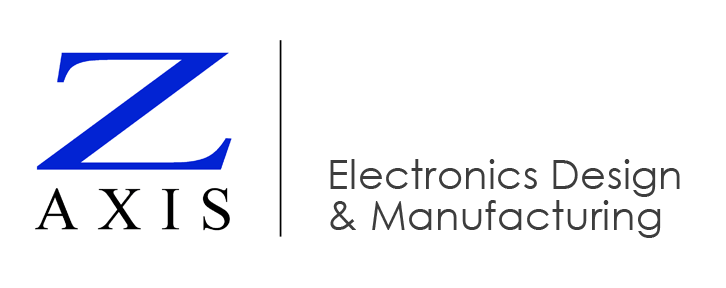This video from Z-AXIS shows our SMT pick and place process. Surface mount technology (SMT) mounts components directly onto the surface of a printed circuit board and is one of our PCBA assembly services.
From Electronic Design to PCB Assembly
Before surface mount pick and place happens, however, Z-AXIS’s electrical engineer can design or help design your circuit. As this video shows, our electronics design services involve creating board layouts that show part placement and the routing of traces.
From this layout, we can procure PCBs with a circuit printed on them, along with a corresponding solder paste stencil and all of the components.
At this point, SMT assembly can begin. As the video shows, Z-AXIS uses high-speed, high-mix SMT assembly lines. These machines are made by Mycronic and are optimized for flexibility. That means we can quickly change from one product to the next and perform a mix of low-to-mid-volume runs very efficiently.
To get started, the boards are fed into an automatic stencil printer, which puts down a layer of paste on to the printed circuit. The solder paste consists of tiny beads of metal solder in a tacky flux that adheres to the metal areas on the printed circuit board.
SMT Pick and Place: Parts Feeding and Machine Vision
Next, the board is fed into an SMT pick and place machine. Nozzles use vacuum pressure to pick-up parts and then place them into the solder paste on the board. These are dual-head machines. Each head picks up eight parts, places them, and goes back for more.
The red flash that you’ll see in the video is the machine vision system for the SMT pick and place machine. With each flash, a picture of the parts is taken. This information is used to rotate and translate each nozzle so that every part is perfectly aligned to its pad on the board within microns.
Tool Changing, Tray Handling, and Feeder Loading
As needed, an automatic tool changer switches to different nozzles for different parts. If there’s a bad part, the machine rejects it and grabs the next one from the feeder. Different feeders handle the different types of component packages: reels for high-volume parts, tubes for larger parts, and trays for things like ball-grid arrays (BGAs)
This automated tray handling system allows Z-AXIS to load up lots of trays and let our SMT pick and place machines to run without manual intervention. Mycronic SMT lines have the fastest changeover in the industry and, whenever a new reel is loaded, can test passives for value and diodes for polarity. This prevents waste and rework if we receive a mislabeled reels, which not an uncommon occurrence in the electronics supply chain.
The line control software uses kitting and part commonality to minimize feeder loading between jobs. Ever reel, tube, or tray has a barcode that we associate with the barcode on the feeder when the feeder is loaded. This provides us powerful parts traceability. In short, Z-AXIS can store, manufacture, and date-code every batch of SMT assemblies that we produce.
SMT Lines and MY300HX Mycronic Machines
Each of our SMT pick and place lines has two different surface mount pick and place machine to full place each board. Line balancing software uses input from the board layout files to determine which machine will place parts.
This supports optimal efficiency and usually means that the MY300HX, Mycronic’s fastest machine, will place most of the smaller parts at up to 33,000 parts per hour. The MY300HX machine will also place larger or oddly-shaped parts at up to 10,000 parts per hour.
Z-AXIS has two identical SMT pick and place lines, but the flexibility of these systems lets us respond to last-minute changes in customer demand. We can also easily work in scheduled maintenance.
Reflow Ovens and SMT Pick and Place
The next machine in each line is a reflow oven. Here, the solder melts and reflows. Then it hardens to bond the components into place and form the electrical connections. Next, each board is inspected using an automated optical inspection system.
After that, a lot of different things could happen to finish the assembly. For example, it might go through the SMT pick and place process again for the second side. It will be cleaned, if needed, de-paneled, and may even have through-hole components added by machine or by hand.
The finished printed circuit board assembly also goes through a burn-in and gets a protective conformal coating. Finally, the PCBA can be packaged in custom trays for shipment. Z-AXIS has videos on these and other topics, so we invite you to continue exploring our website and contact us to discuss your electronics project.
